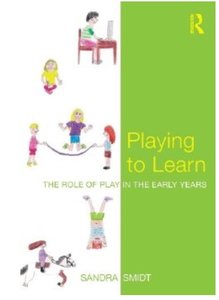Playing to LearnThe role of play in the early years
|

|
 Diese Seite wurde seit 3 Jahren inhaltlich nicht mehr aktualisiert.
Unter Umständen ist sie nicht mehr aktuell.
Diese Seite wurde seit 3 Jahren inhaltlich nicht mehr aktualisiert.
Unter Umständen ist sie nicht mehr aktuell.
 Zusammenfassungen
Zusammenfassungen
 Sandra Smidt sets out to explain what play is and why it is so important as one of the key ways of learning, particularly - but not solely - for young children. She argues that all play is purposeful, and can only truly considered to be play when the child has chosen what to do, where and how to do it.
Using case studies drawn from all over the world, Smidt challenges some of the prevailing myths relating to play and pays close attention to what it is that early years professionals need to do to interpet the play, understand its purpose for the child and sometimes extend it.
Attention is paid to the close links that play has with creativity, and the author also highlights the importance of being able to explain to colleagues, parents and even those in government, why play matters so much in terms of learning and development.
This book will be of interest to anyone involved in early years’ education.
Sandra Smidt sets out to explain what play is and why it is so important as one of the key ways of learning, particularly - but not solely - for young children. She argues that all play is purposeful, and can only truly considered to be play when the child has chosen what to do, where and how to do it.
Using case studies drawn from all over the world, Smidt challenges some of the prevailing myths relating to play and pays close attention to what it is that early years professionals need to do to interpet the play, understand its purpose for the child and sometimes extend it.
Attention is paid to the close links that play has with creativity, and the author also highlights the importance of being able to explain to colleagues, parents and even those in government, why play matters so much in terms of learning and development.
This book will be of interest to anyone involved in early years’ education. Dieses Buch erwähnt ...
Dieses Buch erwähnt ...
 Personen KB IB clear | Carlina Rinaldi , Lew Semjonowitsch Vygotsky | ||||||||||||||||||||||||||||||||||||
 Begriffe KB IB clear |  Kinder Kinder children
, children
,  Lernen Lernen learning
, Reggio-PädagogikReggio approach
, learning
, Reggio-PädagogikReggio approach
,  Spiel Spiel game game
| ||||||||||||||||||||||||||||||||||||
 Bücher |
|
 Dieses Buch erwähnt vermutlich nicht ...
Dieses Buch erwähnt vermutlich nicht ... 
 Nicht erwähnte Begriffe | Eltern, LehrerIn, Schule, Unterricht |
 Tagcloud
Tagcloud
 Zitationsgraph
Zitationsgraph
 Zitationsgraph (Beta-Test mit vis.js)
Zitationsgraph (Beta-Test mit vis.js)
 Volltext dieses Dokuments
Volltext dieses Dokuments
 Bibliographisches
Bibliographisches 
 Beat und dieses Buch
Beat und dieses Buch
Beat hat dieses Buch während seiner Zeit am Institut für Medien und Schule (IMS) ins Biblionetz aufgenommen. Beat besitzt kein physisches, aber ein digitales Exemplar. (das er aber aus Urheberrechtsgründen nicht einfach weitergeben darf). Aufgrund der wenigen Einträge im Biblionetz scheint er es nicht wirklich gelesen zu haben. Es gibt bisher auch nur wenige Objekte im Biblionetz, die dieses Werk zitieren.












 , 3441 kByte)
, 3441 kByte) 

 Biblionetz-History
Biblionetz-History